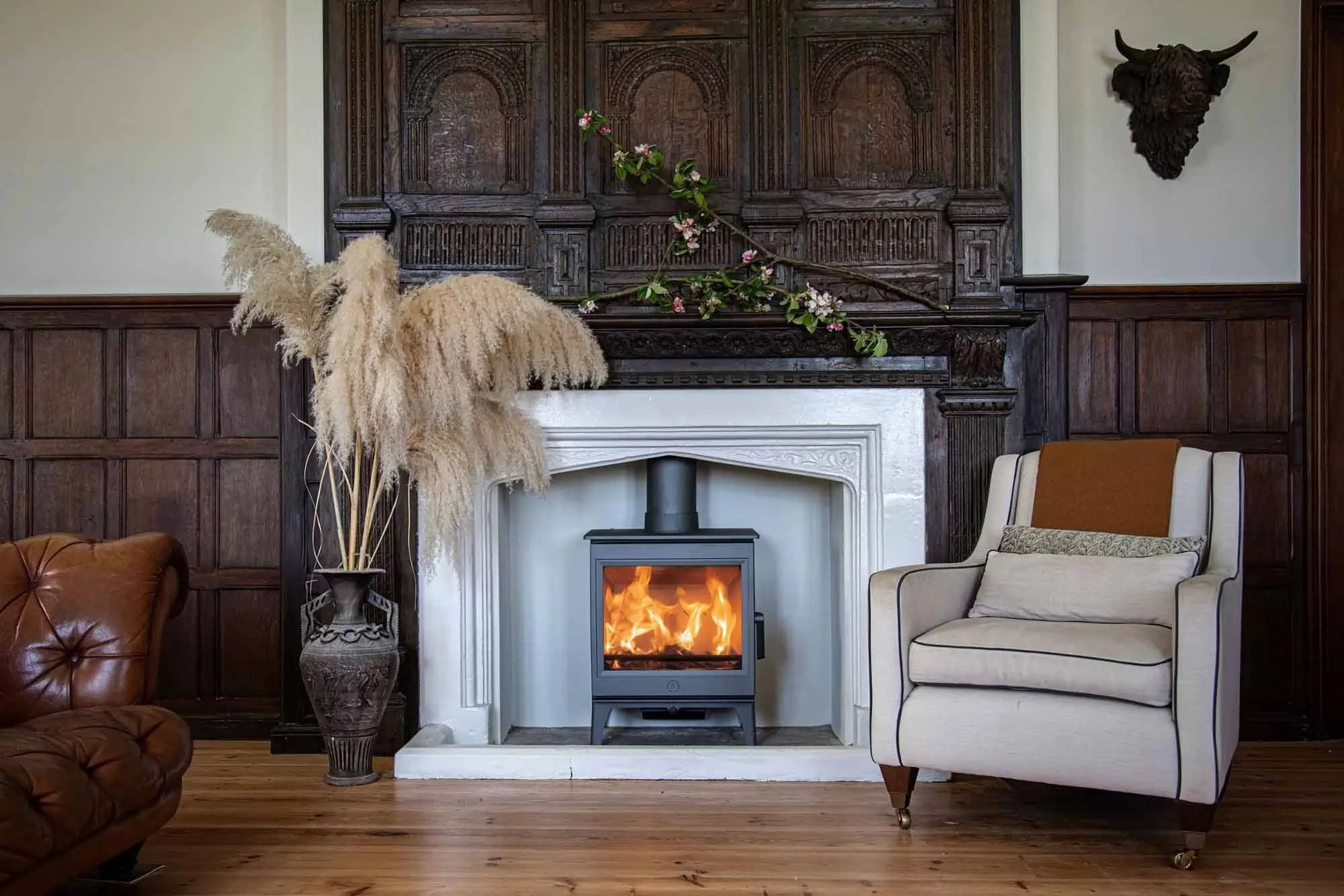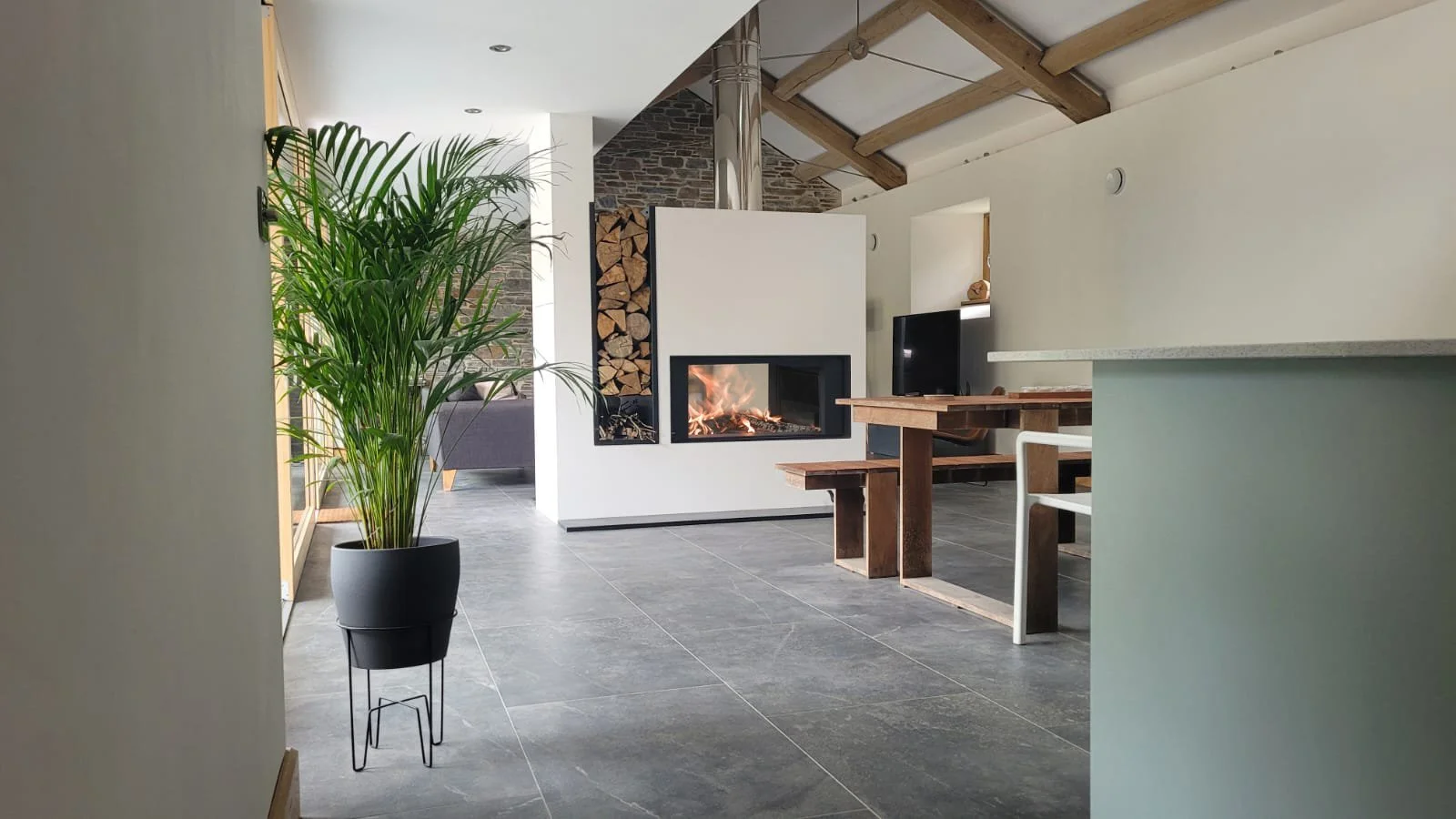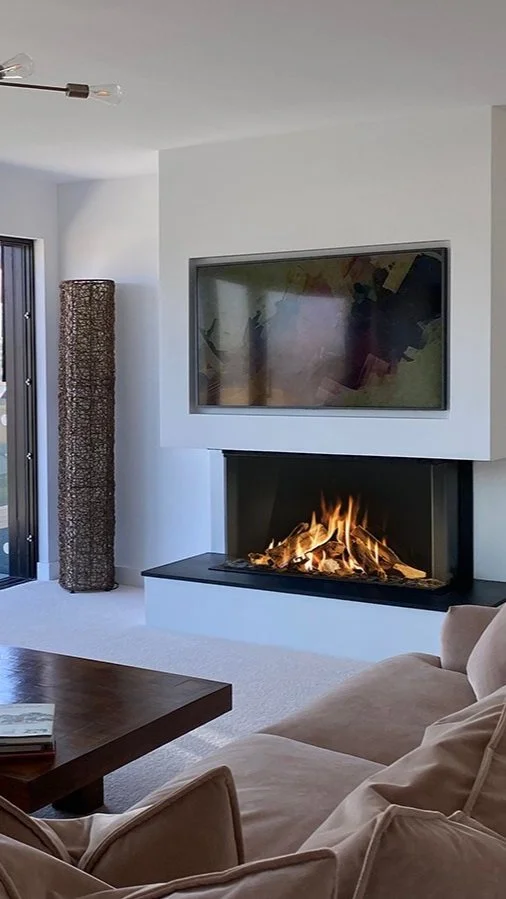Wood vs. Gas vs. Multi-Fuel Stoves…
The Ultimate Comparison Guide for Eco-Conscious Homeowners
When it comes to heating your home, the choices available have never been greater. From traditional wood burning stoves to modern gas options and versatile multi-fuel alternatives, each heating solution offers its own unique benefits and considerations. As homeowners increasingly focus on both cost effectiveness and environmental impact, understanding the differences between these options has become essential to making an informed decision.
Wood Burning Stoves: The Natural Choice
A stunning double sided woodburning fireplace designed and installed by Kernow Fires
Also called a log burner or simply a stove, a wood-burning stove is the most popular type of solid fuel heating appliance in UK homes. With their timeless charm and rustic appeal, they offer an attractive way to bring warmth and comfort to your living space.
What Makes Wood Burning Stoves Special?
Wood burning stoves are closed-fronted heating devices that burn wood to generate heat. The main components include a firebox, door, air vents and controls, baffle, ash pan, flue collar and stove pipe. Modern wood burners are designed with exceptional efficiency and minimal emissions in mind.
One of the most appealing aspects of wood burners is their offering a comforting sound and smell that simply cannot be replicated by other heating options. The natural crackling noise and scent of wood fire creates an ambiance that many homeowners find irresistible.
Environmental Benefits of Wood Burning
Wood is considered a carbon neutral form of energy, making it a more environmentally friendly option. The process releases roughly the same amount of carbon dioxide that a tree absorbs while growing. When you use Ready to Burn wood fuel (properly seasoned or kiln dried wood), you're choosing a sustainable heating method with a significantly lower environmental impact than fossil fuels.
According to industry data, burning kiln dried logs produces just 0.024 KgCO2e per kWh, compared to 0.210 KgCO2e per kWh for mains gas – nearly nine times less carbon impact!
Cost Savings with Wood Burning Stoves
The Stove Industry Alliance (SIA) reports that wood burners can cost a third of the price of electric heating and approximately 13% less than gas central heating to operate. This makes them an increasingly attractive option as energy prices continue to rise.
Wood burning stoves typically range from £1,800 to £7,000 for high-quality models, with installation costs averaging around £2,000. While this represents an initial investment, the long-term savings on fuel costs can be substantial, especially if you have access to locally sourced firewood.
A beautiful Gas Fire designed and installed by Kernow Fires in Padstow, Cornwall
Gas Stoves: Convenience and Control
Gas stoves are fueled using natural, mains gas and feature a burner under an arrangement of artificial fuel – this can be either wood logs, coal or even pebbles and stones. They typically feature simple controls such as an adjustable on/off dial for the gas flow, an ignition button, and often a handheld remote control.
The Appeal of Gas Stoves
Gas stoves offer unmatched convenience – simply turn a dial or press a button for instant heat. Modern gas stoves have come a long way in terms of design, with flame patterns that are virtually indistinguishable from a real fire. They also feature important safety elements including room temperature control, oxygen depletion sensors and flame failure devices.
For homeowners seeking a clean, low-maintenance option, gas stoves eliminate the need for fuel storage and ash removal. They deliver consistent heat output with each use and often come with programmable thermostats for precise temperature control.
Cost Considerations for Gas Stoves
Gas stoves typically cost more to purchase than wood burning options, with prices ranging from approximately £2,500 to £7,500 for high-end models. Installation costs are generally lower, averaging around £850, but require a Gas Safe registered professional.
However, it's worth noting that a wood burning stove, particularly one made of cast iron, will continue to radiate heat long after the fire has died down, offering extended warmth that a gas stove cannot match.
Get an estimate for your new gas fire today
Multi-Fuel Stoves: Versatility with Compromises
Multi-fuel stoves offer the flexibility to burn various fuel types including wood logs, peat or turf briquettes, anthracite, and smokeless coal. This versatility makes them appealing to those who want options based on fuel availability and cost fluctuations.
How Multi-Fuel Stoves Differ
The key structural difference in multi-fuel stoves is the raised (riddling) grate at the bottom that allows air to circulate underneath the fuel bed. This design is essential for burning coal, which requires air from below to combust properly. The ash falls through this grate into an ash pan that needs regular emptying.
While this design offers flexibility, it comes with a significant drawback – reduced efficiency when burning wood. Wood burns best on a flat bed of ash with air coming from above, making the raised grate design less than ideal for wood fuel. If you primarily burn wood in a multi-fuel stove, you may find yourself with less heat output and less efficient combustion.
Important Considerations for Multi-Fuel Stoves
It's crucial to understand that while multi-fuel stoves can burn different types of fuel, burning wood and smokeless coal together is inadvisable. This combination creates problems because:
Smokeless coal needs air from underneath while wood requires air from above, meaning one or both fuels will burn inefficiently
Moisture from the wood can mix with sulphur in the smokeless coal, creating caustic chemicals that can damage your stove's internal components and flue liner
If you're considering a multi-fuel stove but plan to predominantly burn wood, be aware that you'll be compromising on efficiency and environmental benefits compared to a dedicated wood burning stove.
Making Your Decision: Which Stove Is Right for You?
When choosing between wood, gas, and multi-fuel options, consider these key factors:
For Wood Burning Stoves
Best for those who value authenticity, ambiance, and the cosy atmosphere of a real wood fire
Ideal if environmental impact is a priority (especially when using properly dried wood)
Cost-effective for long-term heating, particularly with access to affordable wood sources
Offers energy independence during power outages
Requires space for wood storage and regular maintenance
For Gas Stoves
Perfect for those prioritizing convenience and cleanliness
Excellent if instant, controllable heat is important
Requires no fuel storage space
Minimal maintenance compared to solid fuel options
Higher purchase cost but generally lower installation expense
For Multi-Fuel Stoves
Best for those wanting fuel flexibility based on availability and cost Electric stoves
Consider carefully if you'll primarily burn wood, as efficiency will be compromised
Requires more frequent ash removal and maintenance
Similar price range to wood burning stoves
Beyond the Traditional: Additional Heating Options
While our focus has been on wood, gas, and multi-fuel stoves, we also offer several other heating solutions including:
Electric stoves - Zero emissions at point of use, simple installation with no flue required
Water vapour systems - Creates realistic flame effects using water and light technology
Bioethanol fires - Clean-burning renewable fuel option with no flue requirements
Making the Sustainable Choice
As we look toward a more environmentally conscious future, wood burning stoves represent an excellent balance between traditional heating, cost-effectiveness, and environmental responsibility. When operated properly with kiln dried or properly seasoned wood, they offer significant advantages over both gas and multi-fuel alternatives.
If you're ready to explore your heating options, our experienced team can guide you through selecting the perfect solution for your home, whether you choose the natural charm of a wood burning stove, the convenience of gas, or any of our other high-quality heating options.



